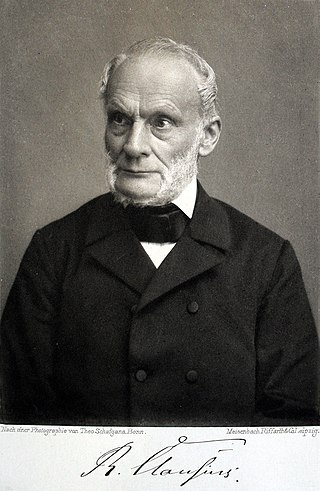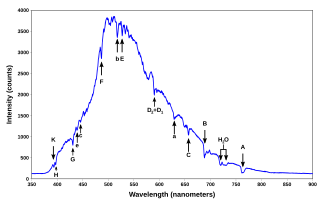Related Research Articles

William Hyde Wollaston was an English chemist and physicist who is famous for discovering the chemical elements palladium and rhodium. He also developed a way to process platinum ore into malleable ingots.

Rudolf Julius Emanuel Clausius was a German physicist and mathematician and is considered one of the central founding fathers of the science of thermodynamics. By his restatement of Sadi Carnot's principle known as the Carnot cycle, he gave the theory of heat a truer and sounder basis. His most important paper, "On the Moving Force of Heat", published in 1850, first stated the basic ideas of the second law of thermodynamics. In 1865 he introduced the concept of entropy. In 1870 he introduced the virial theorem, which applied to heat.

Louis Carl Heinrich Friedrich Paschen, was a German physicist, known for his work on electrical discharges. He is also known for the Paschen series, a series of hydrogen spectral lines in the infrared region that he first observed in 1908. He established the now widely used Paschen curve in his article "Über die zum Funkenübergang in Luft, Wasserstoff und Kohlensäure bei verschiedenen Drücken erforderliche Potentialdifferenz". He is known for the Paschen-Back effect, which is the Zeeman effect's becoming non-linear at high magnetic field. He helped explain the hollow cathode effect in 1916.
The year 1901 in science and technology involved some significant events, listed below.
The year 1827 in science and technology involved some significant events, listed below.

The year 1905 in science and technology involved some significant events, particularly in physics, listed below.

The Fraunhofer lines are a set of spectral absorption lines. They are dark absorption lines, seen in the optical spectrum of the Sun, and are formed when atoms in the solar atmosphere absorb light being emitted by the solar photosphere. The lines are named after German physicist Joseph von Fraunhofer, who observed them in 1814.
The year 1822 in science and technology involved some significant events, listed below.
The year 1819 in science and technology involved some significant events, listed below.
The year 1879 in science and technology involved some significant events, listed below.
The year 1875 in science and technology involved some significant events, listed below.
The year 1845 in science and technology involved some significant events, listed below.
The year 1865 in science and technology involved some significant events, listed below.
The year 1864 in science and technology included many events, some of which are listed here.
In electromagnetism, the Clausius–Mossotti relation, named for O. F. Mossotti and Rudolf Clausius, expresses the dielectric constant of a material in terms of the atomic polarizability, α, of the material's constituent atoms and/or molecules, or a homogeneous mixture thereof. It is equivalent to the Lorentz–Lorenz equation, which relates the refractive index of a substance to its polarizability. It may be expressed as:

Thomas Penyngton Kirkman FRS was a British mathematician and ordained minister of the Church of England. Despite being primarily a churchman, he maintained an active interest in research-level mathematics, and was listed by Alexander Macfarlane as one of ten leading 19th-century British mathematicians. In the 1840s, he obtained an existence theorem for Steiner triple systems that founded the field of combinatorial design theory, while the related Kirkman's schoolgirl problem is named after him.

The Kaufmann–Bucherer–Neumann experiments measured the dependence of the inertial mass of an object on its velocity. The historical importance of this series of experiments performed by various physicists between 1901 and 1915 is due to the results being used to test the predictions of special relativity. The developing precision and data analysis of these experiments and the resulting influence on theoretical physics during those years is still a topic of active historical discussion, since the early experimental results at first contradicted Einstein's then newly published theory (1905), but later versions of this experiment confirmed it. For modern experiments of that kind, see Tests of relativistic energy and momentum, for general information see Tests of special relativity.
The mechanomyogram (MMG) is the mechanical signal observable from the surface of a muscle when the muscle is contracted. At the onset of muscle contraction, gross changes in the muscle shape cause a large peak in the MMG. Subsequent vibrations are due to oscillations of the muscle fibres at the resonance frequency of the muscle. The mechanomyogram is also known as the phonomyogram, acoustic myogram, sound myogram, vibromyogram or muscle sound.

Modern spectroscopy in the Western world started in the 17th century. New designs in optics, specifically prisms, enabled systematic observations of the solar spectrum. Isaac Newton first applied the word spectrum to describe the rainbow of colors that combine to form white light. During the early 1800s, Joseph von Fraunhofer conducted experiments with dispersive spectrometers that enabled spectroscopy to become a more precise and quantitative scientific technique. Since then, spectroscopy has played and continues to play a significant role in chemistry, physics and astronomy. Fraunhofer observed and measured dark lines in the Sun's spectrum, which now bear his name although several of them were observed earlier by Wollaston.
Wilhelm Gottlieb Hankel was a German physicist who was among the first to identify pyroelectric effects and the rotation of the plane of optical polarization in fluorspar upon application of electricity.
References
- ↑ Reynolds, John W. (1850). "XV.—On "propylene," a new hydrocarbon of the series C n H n". Quarterly Journal of the Chemical Society. 3 (2): 111–120. doi:10.1039/QJ8510300111.
- ↑ Wilson, David B., ed. (1990). The Correspondence between Sir George Gabriel Stokes and Sir William Thomson, Baron Kelvin of Largs, Volume 1: 1846–1869. Cambridge, England: Cambridge University Press. pp. 96–97. ISBN 9780521328319.
- ↑ Stokes, G. G. (1856). "On the numerical calculation of a class of definite integrals and infinite series". Transactions of the Cambridge Philosophical Society. 9 (1): 166–188.
- ↑ "Query VI". The Lady's and Gentleman's Diary .
- ↑ Tahta, Dick (2006). The Fifteen Schoolgirls. Cambridge: Black Apollo Press. ISBN 1-900355-48-5.
- ↑ London, Edinburgh & Dublin Philosophical Magazine37 (1850) p. 369 ( OED ).
- ↑ Crilly, Tony (2007). 50 Mathematical Ideas you really need to know. London: Quercus. p. 156. ISBN 978-1-84724-008-8.
- ↑ Evans, Alun (2001). "Benjamin Guy Babington: Founding President of the London Epidemiological Society". International Journal of Epidemiology . 30 (2): 226–230. doi: 10.1093/ije/30.2.226 . PMID 11369720.
- ↑ "History". Central Mental Hospital Carers. Retrieved 2014-11-22.
- ↑ Clausius, R. (1850). "Über die bewegende Kraft der Wärme, pt I". Annalen der Physik . 79: 368–397. Bibcode:1850AnP...155..368C. doi:10.1002/andp.18501550306. hdl: 2027/uc1.$b242250 . Retrieved 2011-04-26. "Pt II". Annalen der Physik . 155: 500–524. Bibcode:1850AnP...155..500C. doi:10.1002/andp.18501550403. hdl: 2027/uc1.$b242250 . English translation as "On the Moving Force of Heat, and the Laws regarding the Nature of Heat itself which are deducible therefrom". Philosophical Magazine . 2: 1–21, 102–119. 1851. Retrieved 2011-04-26.
- ↑ Burke, James (1978). Connections. London: Macmillan. p. 240. ISBN 0-333-24827-9.
- ↑ Trachtenberg, Marvin; Hyman, Isabelle (1986). Architecture: from Prehistory to Post-Modernism – the Western tradition. London: Academy Editions. p. 478. ISBN 0856708992.
- ↑ "Copley Medal | British scientific award". Encyclopædia Britannica. Retrieved 23 July 2020.
- ↑ "The Geological Society of London – Wollaston Medal". www.geolsoc.org.uk. Retrieved 23 July 2020.